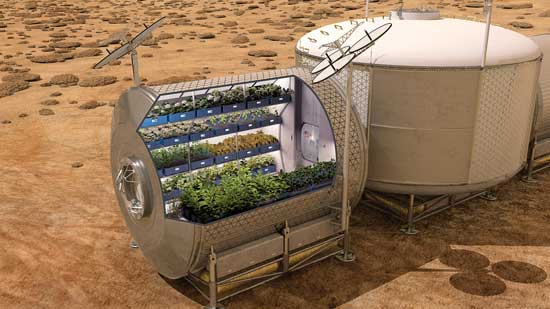Menu planning for mission to Mars
CUTTING EDGE TECHNOLOGY
Menu planning for mission to Mars
In less than a generation, humankind will step foot on Mars. One of the challenges currently being explored is what to eat along the flight (a one-way trip will take about seven months) and what to dine on during the astronauts’ stay on the red planet and their return trip to Earth. Ongoing NASA research is helping to set the table and plan the menu.
Salad Days
Last summer, astronauts aboard the International Space Station harvested red romaine lettuce from the Veggie plant growth system on the orbiting laboratory. NASA’s plant experiment, called Veg-01, was used to study the in-orbit function and performance of the plant growth facility and its rooting “pillows,” which contain the seeds. Half the greens were eaten by the astronauts and the other half were packed and frozen for return to Earth for scientific analysis.
 The Vegetable Production System (Veggie) is a deployable plant growth unit capable of producing salad-type crops to provide the crew with a palatable, nutritious, and safe source of fresh food as well as a tool to support relaxation and recreation. The Veggie provides lighting and nutrient delivery, but utilizes the cabin environment for temperature control and as a source of carbon dioxide to promote growth.
The Vegetable Production System (Veggie) is a deployable plant growth unit capable of producing salad-type crops to provide the crew with a palatable, nutritious, and safe source of fresh food as well as a tool to support relaxation and recreation. The Veggie provides lighting and nutrient delivery, but utilizes the cabin environment for temperature control and as a source of carbon dioxide to promote growth.
NASA is developing Veggie technology aboard the space station to provide future pioneers with a sustainable food supplement—a critical part of NASA’s Journey to Mars program. As NASA moves toward long-duration exploration missions farther into the solar system, Veggie will be a resource for crew food growth and consumption. It also could be used by astronauts for recreational gardening activities during deep space missions.
The collapsible and expandable Veggie unit features a flat panel light bank that includes red, blue, and green LEDs for plant growth and crew observation. Using LED lights to grow plants was an idea that originated with NASA as far back as the late 1990s. The purple/pinkish hue surrounding the plants in Veggie is the result of a combination of the red and blue lights, which by design emit more light than the green LEDs. Green LEDS were added so the plants look like edible food rather than weird purple plants.
Having fresh food like the lettuce available in space could have a positive impact on people’s moods and also could provide some protection against radiation in space.
Potatoes
NASA is also currently working with researchers at the International Potato Center (CIP) in Peru to determine if potatoes can one day be grown on the surface of Mars. The first tests will be done in labs in Lima using soil from Pampas de la Joya, an area in the northern Atacama Desert that is extremely dry and receives less than 1 mm of rain annually. The growing conditions will attempt to replicate the Martian climate and atmosphere of drastic temperature swings and UV radiation. About 100 different potato varieties have been selected for the research, including some very rare tubers. Forty of the varieties are native to the Andes Mountains and 60 varieties have been genetically modified to withstand drought.
If the experiments are favorable, the researchers plan to move the study to the desert and plant the potatoes directly in the arid soil. In addition to Mars, the project may help to uncover suitable potato varieties for climate change here on Earth.
NASA selected the potato for its nutrients, water efficiency, and growing condition adaptability from sea level to high altitudes and from the tropics to cold climates.
Dried Plums
New animal research published in Scientific Reports suggests that dried plums may help to prevent bone loss in individuals exposed to radiation, such as astronauts in space. Radiation workers and those who receive radiation therapy as part of a treatment for cancer are also subject to possible bone loss from exposure to radiation. While dried plums have been linked to bone health in previous studies, this emerging research explores the bone-preserving role of dried plums specific to radiation exposure.
Researchers from the University of California-San Francisco, University of California-Irvine, and Texas A&M University looked at the effect of various antioxidant or anti-inflammatory interventions—including an antioxidant cocktail, dihydrolipoic acid (antioxidant), ibuprofen (anti-inflammatory), dried plum powder (antioxidant), and a control—on mice that received radiation.
Researchers observed that the dried plum powder was the most effective in reducing undesired bone marrow cells’ responses to radiation compared to the other interventions. Additionally, the researchers observed that mice on the dried plum diet did not exhibit decrements (bone volume loss) after exposure to radiation in any of the structural parameters measured. The results of this study “Dried plum diet protects from bone loss caused by ionizing radiation” suggest that dried plums may serve as an effective intervention for bone loss due to unavoidable exposure to space radiation or radiation therapy.
If you are working on or know of some cutting edge technology that you would like to be featured in this column, please send an email to [email protected].
